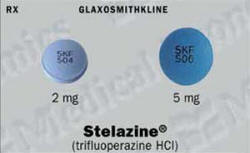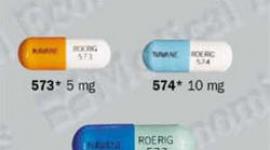Stelazine (Trifluoperazine) Patient Information
Find out why Stelazine is prescribed, side effects of Stelazine, Stelazine warnings, effects of Stelazine during pregnancy, more - in plain English.
Generic name: Trifluoperazine hydrochloride
Brand name: Stelazine
Pronounced: STEL-ah-zeen
Full Stelazine Prescribing Information
Why is Stelazine prescribed?
Stelazine is used for the treatment of schizophrenia (severe disruptions in thought and perception). It is also prescribed for anxiety that does not respond to ordinary tranquilizers.
Most important fact about Stelazine
Stelazine may cause tardive dyskinesia--a condition marked by involuntary muscle spasms and twitches in the face and body. This condition may be permanent and appears to be most common among the elderly, especially women. Ask your doctor for information about this possible risk.
How should you take Stelazine?
If taking Stelazine in a liquid concentrate form, you will need to dilute it with a liquid such as a carbonated beverage, coffee, fruit juice, milk, tea, tomato juice, or water. You can also use puddings, soups, and other semisolid foods. Stelazine should be diluted just before you take it.
You should not take Stelazine with alcohol.
--If you miss a dose...
Why is Stelazine prescribed?
Stelazine is used for the treatment of schizophrenia (severe disruptions in thought and perception). It is also prescribed for anxiety that does not respond to ordinary tranquilizers.
Most important fact about Stelazine
Stelazine may cause tardive dyskinesia--a condition marked by involuntary muscle spasms and twitches in the face and body. This condition may be permanent and appears to be most common among the elderly, especially women. Ask your doctor for information about this possible risk.
How should you take Stelazine?
If taking Stelazine in a liquid concentrate form, you will need to dilute it with a liquid such as a carbonated beverage, coffee, fruit juice, milk, tea, tomato juice, or water. You can also use puddings, soups, and other semisolid foods. Stelazine should be diluted just before you take it.
You should not take Stelazine with alcohol.
--If you miss a dose...
If you take 1 dose a day, take the dose you missed as soon as you remember. Then go back to your regular schedule. If you do not remember until the next day, skip the missed dose and go back to your regular schedule.
If you take more than 1 dose a day, take the dose you missed if it is within an hour or so of the scheduled time. If you do not remember until later, skip the missed dose and go back to your regular schedule. Do not take 2 doses at once.
--Storage instructions...
Store at room temperature. Protect the concentrate from light.
What side effects may occur with taking Stelazine?
Side effects cannot be anticipated. If any develop or change in intensity, inform your doctor as soon as possible. Only your doctor can determine if it is safe for you to continue taking Stelazine.
- Side effects of Stelazine may include: Abnormal secretion of milk, abnormal sugar in urine, abnormalities in movement and posture, agitation, allergic reactions (sometimes severe), anemia, asthma, blood disorders, blurred vision, body rigidly arched backward, breast development in males, chewing movements, constipation, constricted pupils, difficulty swallowing, dilated pupils, dizziness, drooling, drowsiness, dry mouth, ejaculation problems, exaggerated or excessive reflexes, excessive or spontaneous flow of milk, eye problems causing a state of fixed gaze, eye spasms, fatigue, fever or high fever, flu-like symptoms, fluid accumulation and swelling (including the brain), fragmented movements, headache, heart attack, high or low blood sugar, hives, impotence, inability to urinate, increase in appetite and weight, infections, insomnia, intestinal blockage, involuntary movements of tongue, face, mouth, jaw, arms, and legs, irregular blood pressure, pulse, and heartbeat, irregular or no menstrual periods, jitteriness, light-headedness (especially when standing up), liver damage, lockjaw, loss of appetite, low blood pressure, mask-like face, muscle stiffness and rigidity, nasal congestion, nausea, persistent, painful erections, pill-rolling movement, protruding tongue, puckering of mouth, puffing of cheeks, purple or red spots on the skin, rapid heartbeat, restlessness, rigid arms, feet, head, and muscles, seizures, sensitivity to light, shuffling walk, skin inflammation and peeling, skin itching, pigmentation, reddening, or rash, spasms in jaw, face, tongue, neck, hands, feet, back, and mouth, sweating, swelling of the throat, totally unresponsive state, tremors, twisted neck, weakness, yellowing of skin and whites of eyes
Why should Stelazine not be prescribed?
You should not be using Stelazine if you have liver damage, or if you are taking central nervous system depressants such as alcohol, barbiturates, or narcotic pain relievers. Stelazine should not be used if you have an abnormal bone marrow or blood condition.
Special warnings about Stelazine
You should use Stelazine cautiously if you have ever had a brain tumor, breast cancer, intestinal blockage, the eye condition called glaucoma, heart or liver disease, or seizures. Be cautious, too, if you are exposed to certain pesticides or extreme heat. Be aware that Stelazine may hide the signs of overdose of other drugs and may make it more difficult for your doctor to diagnose intestinal obstruction, brain tumor, and the dangerous neurological condition called Reye's syndrome.
Tell your doctor if you have ever had an allergic reaction to any major tranquilizer similar to Stelazine.
Dizziness, nausea, vomiting, and tremors can result if you suddenly stop taking Stelazine. Follow your doctor's instructions when discontinuing this drug.
Tell your doctor immediately if you experience symptoms such as a fever or sore throat, mouth, or gums. These signs of infection may signal the need to stop Stelazine treatment. Notify your doctor, too, if you develop flu-like symptoms with fever.
This drug may impair your ability to drive a car or operate potentially dangerous machinery, especially during the first few days of treatment. Do not participate in any activities that require full alertness if you are unsure about your ability.
If you have any trouble with your vision, tell your doctor.
Stelazine concentrate contains a sulfite that may cause allergic reactions in some people, especially in those with asthma.
Stelazine can cause a group of symptoms called Neuroleptic Malignant Syndrome. Signs are high body temperature, rigid muscles, irregular pulse or blood pressure, rapid or abnormal heartbeat, and excessive perspiration.
Possible food and drug interactions when taking Stelazine
Extreme drowsiness and other potentially serious effects can result if Stelazine is combined with alcohol, tranquilizers such as Valium, narcotic painkillers such as Percocet, antihistamines such as Benadryl, and barbiturates such as phenobarbital.
If Stelazine is taken with certain other drugs, the effects of either could be increased, decreased, or altered. It is especially important to check with your doctor before combining Stelazine with the following:
Antiseizure drugs such as Dilantin
Atropine (Donnatal)
Blood thinners such as Coumadin
Guanethidine
Lithium (Lithobid, Eskalith)
Propranolol (Inderal)
Thiazide diuretics such as Dyazide
Special information if you are pregnant or breastfeeding
Pregnant women should use Stelazine only if clearly needed. The effects of Stelazine during pregnancy have not been adequately studied. If you are pregnant or plan to become pregnant, inform your doctor immediately. Stelazine appears in breast milk and may affect a nursing infant. If this medication is essential to your health, your doctor may have you discontinue breastfeeding while you are taking it.
Recommended dosage for Stelazine
ADULTS
Nonpsychotic Anxiety
Doses usually range from 2 to 4 milligrams daily. This amount should be divided into 2 equal doses and taken twice a day. Do not take more than 6 milligrams a day or take the medication for more than 12 weeks.
Schizophrenia
The usual starting dose is 4 to 10 milligrams a day, divided into 2 equal doses; doses range from 15 to 40 milligrams daily.
CHILDREN
 Doses are based on the child's weight and the severity of his or her symptoms.
Doses are based on the child's weight and the severity of his or her symptoms.
Schizophrenia in Children 6 to 12 Years Old Who Are Closely Monitored or Hospitalized
The starting dose is 1 milligram a day, taken all at once or divided into 2 doses. Your doctor will increase the dosage gradually, up to 15 milligrams a day.
OLDER ADULTS
Older people usually take Stelazine at lower doses. Because you may develop low blood pressure while taking this drug, your doctor will watch you closely. Older people (especially older women) may be more susceptible to tardive dyskinesia--a possibly permanent condition characterized by involuntary muscle spasms and twitches in the face and body. Consult your doctor for information about these potential risks.
Overdosage of Stelazine
Any medication taken in excess can have serious consequences. If you suspect an overdose of Stelazine, seek medical help immediately.
- Symptoms of Stelazine overdose may include: Agitation, coma, convulsions, difficulty breathing, difficulty swallowing, dry mouth, extreme sleepiness, fever, intestinal blockage, irregular heart rate, low blood pressure, restlessness
Full Stelazine Prescribing Information
Detailed Info on Signs, Symptoms, Causes, Treatments of Schizophrenia
Detailed Info on Signs, Symptoms, Causes, Treatments of Anxiety Disorders
APA Reference
Staff, H.
(2009, January 4). Stelazine (Trifluoperazine) Patient Information, HealthyPlace. Retrieved
on 2025, November 28 from https://www.healthyplace.com/other-info/psychiatric-medications/stelazine-trifluoperazine-patient-information
